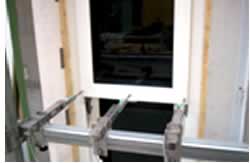An update on window industry standards in the BCA from Australian Window Association
The Australian Window Association (AWA) represents the Australian fenestration
industry at numerous levels. The AWA sits on Standards and Building Code committees, which
evaluates and inputs industry comment on public drafts and amendments. The AWA also holds
discussions with industry partners such as the HIA, Building Designers, Building Surveyors
and the ABCB to ensure window designers and manufacturers are well represented in the decision
and policy making that can affect the window industry.
A vital part of this process is ensuring AWA members (close to 400 Australian window manufacturers
and suppliers to the fenestration industry) and the building industry fully understands their
roles and responsibilities within the system. This article is a reminder of the basic rules
for windows and the reasons for them.
The BCA references acceptable construction manuals and states that performance requirements are
satisfied for glazing and windows if they are designed and constructed in accordance with one
of the following manuals:
- AS 2047 - Windows in Buildings, Selection and Installation;
This is the primary reference for designers, manufacturers and specifiers and must be complied
with, unless the window falls outside the scope of AS 2047, and compliance will therefore
be to the AS below.
- AS 1288 - Glass in Buildings, Selection and Installation.
Compliance to the above codes is mandatory.
 AS2047 'Windows in Buildings - Selection and Installation'
AS2047 'Windows in Buildings - Selection and Installation'
This standard specifies minimum performance requirements for window materials, corrosion,
protection and performance. Windows tested in an accredited laboratory for the following
performance parameters:
- Serviceability (Deflection).
- Ultimate (Strength).
- Water penetration.
- Air infiltration.
- Operating force test.
AS1288 'Glass in Buildings - Selection and Installation'
Provides tables listing appropriate glass thickness and type that complies with the
nominated wind pressures.
AS1170.2 'Wind Loads'
Used by engineers to determine wind loads for a specific project/structure. Calculated
wind loads are expressed in terms of pressure and units are Pascals.
It is difficult to satisfy someone who wants a window to resist a WIND SPEED OF X
m/s. Wind speed has to be converted to pressure (Pascals) using a number of factors
specific to the particular project.
It is not the window manufacturer's responsibility to nominate the wind loads.
THE ARCHITECT OR STRUCTURAL ENGINEER EMPLOYED FOR THE PROJECT OR THE LOCAL GOVERNMENT
SHOULD STIPULATE WHAT PRESSURE IS REQUIRED.
Tracey Gramlick
Technical Director, AWA
Tracey has degree in Engineering, a Masters in Technology Management and over 28 years
of residential and commercial fenestration expertise. Tracey has worked in various
design, technical and marketing roles for companies including Pilkington Curtainwall
and Windows, Alcan and Capral before taking up her current position as Technical
Director of the AWA 4 years ago. Tracey actively participates in numerous Australian
Building Code and Standards Committees, international energy committees and is a
member of the HIA NSW technical committee.
About the AWA:
The AWA nationally represents manufacturers and suppliers to the window, door and
skylight industries. AWA members are audited regularly as part of a national compliance
program accredited by the independent National Association of Testing Authorities
(NATA). Members provide a minimum seven year guarantee to all products and abide by
an industry code of conduct to maintain the high standing of the Australian window industry.
|


 AS2047 'Windows in Buildings - Selection and Installation'
AS2047 'Windows in Buildings - Selection and Installation'
 News and Updates | The Australian Window
News and Updates | The Australian Window Glazing Energy Performance Ratings
Glazing Energy Performance Ratings Window Watch News from Australian Window
Window Watch News from Australian Window Australian Window Association News and
Australian Window Association News and Fenestration Australia Conference |
Fenestration Australia Conference | Australian Window Association NSW
Australian Window Association NSW AWA Design Award winners 2008
AWA Design Award winners 2008 The Australian Window Association
The Australian Window Association Decorative leadlight glass by Spectrum
Decorative leadlight glass by Spectrum Royal treatment for Australian Window
Royal treatment for Australian Window Not all timber windows are equal - the
Not all timber windows are equal - the Window film stars in the energy debate -
Window film stars in the energy debate - Winning windows wanted by the Australian
Winning windows wanted by the Australian Window compliance means business -
Window compliance means business -
